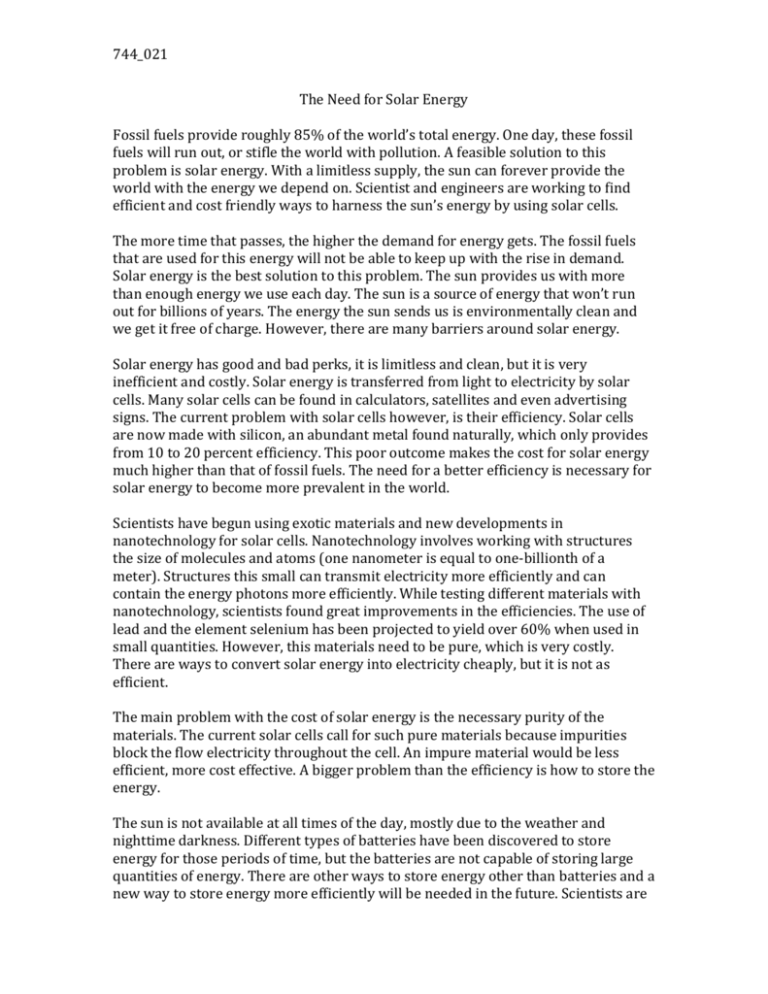744_021
advertisement

744_021 The Need for Solar Energy Fossil fuels provide roughly 85% of the world’s total energy. One day, these fossil fuels will run out, or stifle the world with pollution. A feasible solution to this problem is solar energy. With a limitless supply, the sun can forever provide the world with the energy we depend on. Scientist and engineers are working to find efficient and cost friendly ways to harness the sun’s energy by using solar cells. The more time that passes, the higher the demand for energy gets. The fossil fuels that are used for this energy will not be able to keep up with the rise in demand. Solar energy is the best solution to this problem. The sun provides us with more than enough energy we use each day. The sun is a source of energy that won’t run out for billions of years. The energy the sun sends us is environmentally clean and we get it free of charge. However, there are many barriers around solar energy. Solar energy has good and bad perks, it is limitless and clean, but it is very inefficient and costly. Solar energy is transferred from light to electricity by solar cells. Many solar cells can be found in calculators, satellites and even advertising signs. The current problem with solar cells however, is their efficiency. Solar cells are now made with silicon, an abundant metal found naturally, which only provides from 10 to 20 percent efficiency. This poor outcome makes the cost for solar energy much higher than that of fossil fuels. The need for a better efficiency is necessary for solar energy to become more prevalent in the world. Scientists have begun using exotic materials and new developments in nanotechnology for solar cells. Nanotechnology involves working with structures the size of molecules and atoms (one nanometer is equal to one-billionth of a meter). Structures this small can transmit electricity more efficiently and can contain the energy photons more efficiently. While testing different materials with nanotechnology, scientists found great improvements in the efficiencies. The use of lead and the element selenium has been projected to yield over 60% when used in small quantities. However, this materials need to be pure, which is very costly. There are ways to convert solar energy into electricity cheaply, but it is not as efficient. The main problem with the cost of solar energy is the necessary purity of the materials. The current solar cells call for such pure materials because impurities block the flow electricity throughout the cell. An impure material would be less efficient, more cost effective. A bigger problem than the efficiency is how to store the energy. The sun is not available at all times of the day, mostly due to the weather and nighttime darkness. Different types of batteries have been discovered to store energy for those periods of time, but the batteries are not capable of storing large quantities of energy. There are other ways to store energy other than batteries and a new way to store energy more efficiently will be needed in the future. Scientists are 744_021 working on a way to mimic the process plants use to gain energy from the sun, called photosynthesis. In photosynthesis, plants store their energy in the bonds of molecules for food. This natural process is not easy to mimic and is almost impossible to with the same efficiency. A breakthrough in finding a way to store the energy in the bonds of molecules efficiently would enhance the attractiveness of solar energy. There needs to be many advances in the technology for solar energy to be a main source of power. A new discovery in materials or a technology that stores the energy more efficiently would be a massive breakthrough. Mastering the energy given to us by the sun is a feat that must be met in the near future. http://encyclopedia.kids.net.au/page/so/Solar_cell http://www.engineeringchallenges.org/cms/8996/9082.aspx







